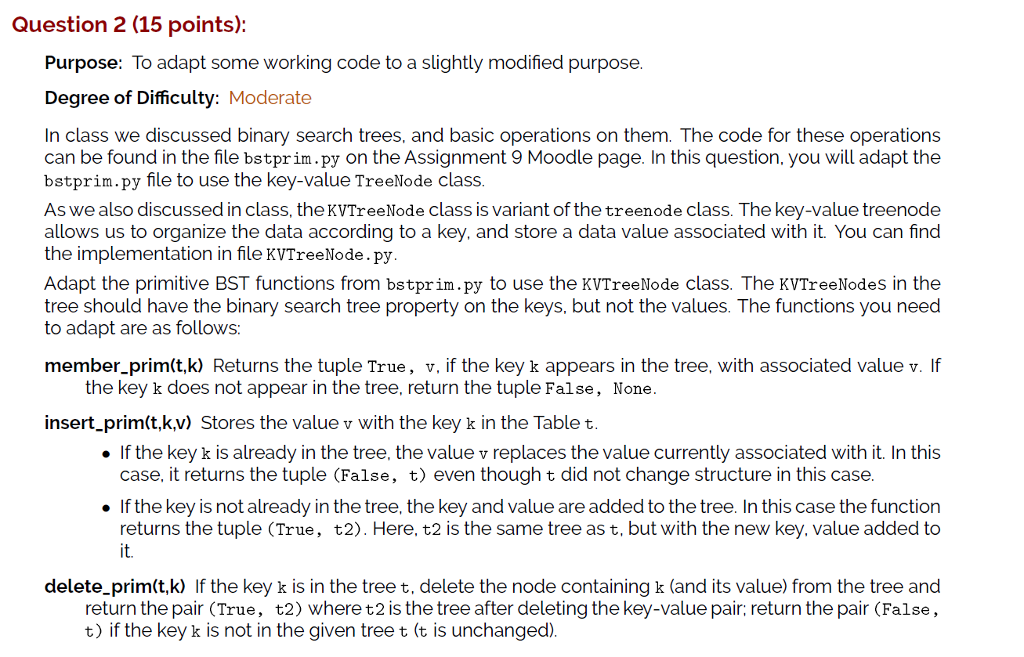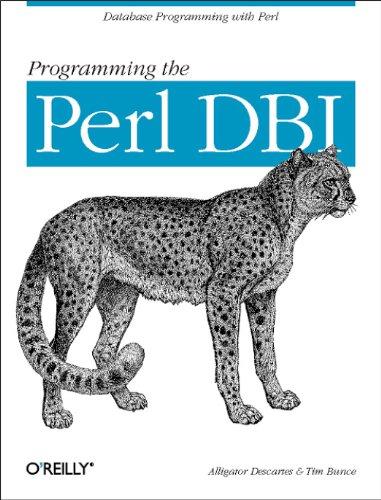Answered step by step
Verified Expert Solution
Question
1 Approved Answer
Python 3.x Changing Starter Code Please just don't copy and paste read the question: What I understand from this question is that I have some
Python 3.x Changing Starter Code Please just don't copy and paste read the question:

What I understand from this question is that I have some starter code that I need to change to work with KVTreenodes which are classes I cannot change the KVTreenode file which must be imported. I also have a testcase to make sure that it's working but since it is so long I'll post it on pastebin(https://pastebin.com/u7zPyRfB)
Here is the starter Code:
import KVTreeNode as TN def member_prim(tnode, key): """ Purpose: Check if value is stored in the binary search tree. Preconditions: :param tnode: a KVTreeNode with the BST property :param key: a key Postconditions: none :return: a pair True, value if key is in the tree a pair False, None if the key is not in the tree """ if tnode is None: return False, None elif tnode.key is key: return True, tnode.value elif key """ Insert a new key,value into the binary search tree. Preconditions: :param tnode: a KVTreeNode with the BST property :param key: a key Postconditions: If the key is not already in the tree, it is added. If the key is already in the tree, the old value is replaced with the given value. Return :return: tuple (flag, tree) flag is True if insertion succeeded; tree contains the new key-value flag is False if the value is already in the tree, the value stored with the key is changed """ return False, None def delete_prim(tnode, key): """ Delete a value from the binary search tree. Preconditions: :param tnode: a KVTreeNode with the BST property :param key: a key Postconditions: If the key is in the tree, it is deleted. The tree retains the binary search tree property. If the key is not there, there is no change to the tree. Return :return: tuple (flag, tree) flag is True if deletion succeeded; tree is the resulting without the value flag is False if the value was not in the tree, tree returned unchanged """ return False, None
KVTreenode.py
# Defines the kv tree node ADT # # A KVTreeNode is a simple container with four pieces of # information: # key: the key for the node # value: the contained information # left: a reference to another KVTreeNode, or None # right: a reference to another KVTreeNode, or None # Implementation notes: # This ADT implementation uses a Python class class KVTreeNode(object): def __init__(self, key, value, left=None, right=None): """ Create a new KVTreeNode for the given data. Pre-conditions: key: A key used to identify the node value: Any data value to be stored in the KVTreeNode left: Another KVTreeNode (or None, by default) right: Another KVTreeNode (or None, by default) """ self.value = value self.left = left self.right = right self.key = keyQuestion 2 (15 points): Purpose: To adapt some working code to a slightly modified purpose. Degree of Difficulty: Moderate In class we discussed binary search trees, and basic operations on them. The code for these operations can be found in the file bstprim.py on the Assignment 9 Moodle page. In this question, you will adapt the bstprim.py file to use the key-value TreeNode class As we also discussed in class, the KVTreeNode class is variant of the treenode class. The key-value treenode allows us to organize the data according to a key, and store a data value associated with it. You can find the implementation in file KVTreeNode. py. Adapt the primitive BST functions from bstprim.py to use the KVTreellode class. The KVTreeNodes in the tree should have the binary search tree property on the keys, but not the values. The functions you need to adapt are as follows: member prim(t,k) Returns the tuple True, v, if the key k appears in the tree, with associated value v. If the key k does not appear in the tree, return the tuple False, None. insert prim(t,k,v) Stores the value v with the key k in the Table t . If the key k is already in the tree, the value v replaces the value currently associated with it. In this case, it returns the tuple (False, t) even though t did not change structure in this case . If the key is not already in the tree, the key and value are added to the tree. In this case the function returns the tuple (True, t2). Here, t2 is the same tree as t, but with the new key, value added to it. delete_prim(t,k) If the key k is in the tree t, delete the node containing k (and its value) from the tree and return the pair (True, t2) where t2 is the tree after deleting the key-value pair, return the pair (False t) if the key k is not in the given tree t (t is unchanged)
Step by Step Solution
There are 3 Steps involved in it
Step: 1

Get Instant Access to Expert-Tailored Solutions
See step-by-step solutions with expert insights and AI powered tools for academic success
Step: 2

Step: 3

Ace Your Homework with AI
Get the answers you need in no time with our AI-driven, step-by-step assistance
Get Started


